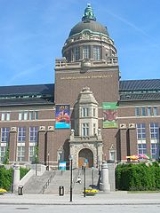
Swedish Museum of Natural History
Encyclopedia
The Swedish Museum of Natural History , in Stockholm
, is one of two major museums of natural history in Sweden
, the other one being located in Gothenburg
.
The museum was founded in 1819 by the Royal Swedish Academy of Sciences
, but goes back to the collections acquired mostly through donations by the Academy since its foundation in 1739. These collections had first been made available to the public in 1786. The Museum was separated from the Academy in 1965.
One of the keepers of the collections of the Academy during its earlier history was Anders Sparrman, a student of Linnaeus
and participant in the voyages of Captain James Cook
. Another important name in the history of the Museum is the zoologist, paleontologist and archaeologist Sven Nilsson
, who brought the previously disorganised zoological collections of the Museum into order during his time as keeper (1828–1831) before returning to Lund
as professor.
The present buildings for the museum in Frescati
, Stockholm, was designed by the architect Axel Anderberg
and completed in 1916, topped with a dome
; the main campus of Stockholm University
was later built next to the museum.
The museum has an IMAX
cinema called Cosmonova. The cinema is also the largest planetarium in Sweden.
Stockholm
Stockholm is the capital and the largest city of Sweden and constitutes the most populated urban area in Scandinavia. Stockholm is the most populous city in Sweden, with a population of 851,155 in the municipality , 1.37 million in the urban area , and around 2.1 million in the metropolitan area...
, is one of two major museums of natural history in Sweden
Sweden
Sweden , officially the Kingdom of Sweden , is a Nordic country on the Scandinavian Peninsula in Northern Europe. Sweden borders with Norway and Finland and is connected to Denmark by a bridge-tunnel across the Öresund....
, the other one being located in Gothenburg
Gothenburg
Gothenburg is the second-largest city in Sweden and the fifth-largest in the Nordic countries. Situated on the west coast of Sweden, the city proper has a population of 519,399, with 549,839 in the urban area and total of 937,015 inhabitants in the metropolitan area...
.
The museum was founded in 1819 by the Royal Swedish Academy of Sciences
Royal Swedish Academy of Sciences
The Royal Swedish Academy of Sciences or Kungliga Vetenskapsakademien is one of the Royal Academies of Sweden. The Academy is an independent, non-governmental scientific organization which acts to promote the sciences, primarily the natural sciences and mathematics.The Academy was founded on 2...
, but goes back to the collections acquired mostly through donations by the Academy since its foundation in 1739. These collections had first been made available to the public in 1786. The Museum was separated from the Academy in 1965.
One of the keepers of the collections of the Academy during its earlier history was Anders Sparrman, a student of Linnaeus
Carolus Linnaeus
Carl Linnaeus , also known after his ennoblement as , was a Swedish botanist, physician, and zoologist, who laid the foundations for the modern scheme of binomial nomenclature. He is known as the father of modern taxonomy, and is also considered one of the fathers of modern ecology...
and participant in the voyages of Captain James Cook
James Cook
Captain James Cook, FRS, RN was a British explorer, navigator and cartographer who ultimately rose to the rank of captain in the Royal Navy...
. Another important name in the history of the Museum is the zoologist, paleontologist and archaeologist Sven Nilsson
Sven Nilsson
Sven Nilsson was a Swedish zoologist and archaeologist, who was director of the Naturhistoriska Riksmuseet , professor of Natural history at Lund University , and rector of the university...
, who brought the previously disorganised zoological collections of the Museum into order during his time as keeper (1828–1831) before returning to Lund
Lund University
Lund University , located in the city of Lund in the province of Scania, Sweden, is one of northern Europe's most prestigious universities and one of Scandinavia's largest institutions for education and research, frequently ranked among the world's top 100 universities...
as professor.
The present buildings for the museum in Frescati
Frescati (Stockholm)
Frescati is a park-like area on the northern outskirts of Stockholm. The name has occationally been spelled Freskati. Originally it was a part of Norra Djurgården but was granted to the societé for building private villas...
, Stockholm, was designed by the architect Axel Anderberg
Axel Anderberg
Axel Johan Anderberg was a Swedish architect active from the 1880s to the early 1930s...
and completed in 1916, topped with a dome
Dome
A dome is a structural element of architecture that resembles the hollow upper half of a sphere. Dome structures made of various materials have a long architectural lineage extending into prehistory....
; the main campus of Stockholm University
Stockholm University
Stockholm University is a state university in Stockholm, Sweden. It has over 28,000 students at four faculties, making it one of the largest universities in Scandinavia. The institution is also frequently regarded as one of the top 100 universities in the world...
was later built next to the museum.
The museum has an IMAX
IMAX
IMAX is a motion picture film format and a set of proprietary cinema projection standards created by the Canadian company IMAX Corporation. IMAX has the capacity to record and display images of far greater size and resolution than conventional film systems...
cinema called Cosmonova. The cinema is also the largest planetarium in Sweden.

